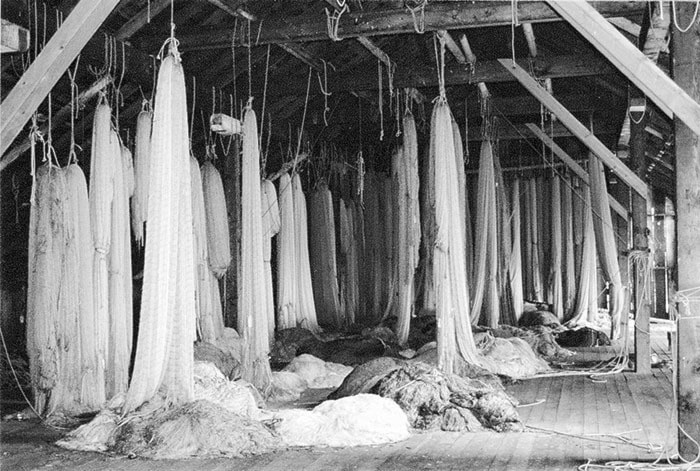Beth Boyce
Museum at Campbell River
In the current temporary exhibit at the Museum at Campbell River, Threads Through Time, A Coastal Textile History, there are many remarkable historic and contemporary works by local artists on display.
One of the most intriguing textiles being shown is the rugs that are made in Sointula. Only a few industrious women make these unique pieces, and what makes these rugs incredible is the material they are made from: old used salmon gill nets. It would appear that the settlers to Sointula had an affinity for gill nets, as the Gill Net Drum was also invented by a Finnish resident of Sointula.
In the 1950s, a new arrival to Sointula from Finland, Helmi Pakkalen, noticed that there were many old discarded gill nets lying about. Never one to waste useful materials, she made several attempts to determine the best use for the old nets, and the eventual result was the Gill Net Rug. These rugs will wear forever, are machine washable, and come in a variety of colours depending upon the initial colour and age of the net.
Helmi taught others the art of making the rugs and they are still being made today, although there are few who make them. The best web for making the rugs is made from several strands of nylon plied together in the style of the old nets, but today it is difficult to find old nets, and as the rug makers will tell you, “you can’t find them at Michaels.” As a result, the material gill nets have been made from has changed over time as today’s nets are made from only a single ply of nylon.
Two of the women still making the rugs today are featured in the Museum’s exhibit: Heather Orr Lansdowne and Wendy Davis. Both women are residents of Sointula, the only place where one can find the rugs for sale. When talking about the rugs and the nets used to make them, both women commented on how the history of the net is a large part of each rug. Heather noted that the nets are over 40 years old before they are made into the rugs.
“They have been on the cork and lead lines, they have been on the drums, and they have been in the ocean.”
Wendy mentioned that each net has a story; the story of who owned them and of where they were used. As a way of honouring a net’s history, both Wendy and Heather say that it is important to them to give the original owner a rug produced from their own net.
The rugs come in a remarkable array of colours depending upon where the net was being used for fishing; from the dark green of Smith Inlet, to the pale blues and creams of Bella Coola. The rugs age well, and will slowly fade in the sun. They can still be found on porches and in doorways of many of the old houses on Sointula.
Like many of the coastal textiles on exhibit at the Museum, they are a testament to the inventiveness of their creators, who have produced items that are at once beautiful and functional.
